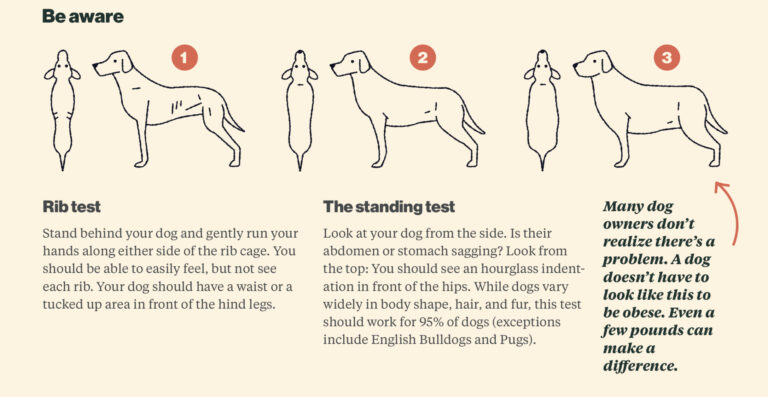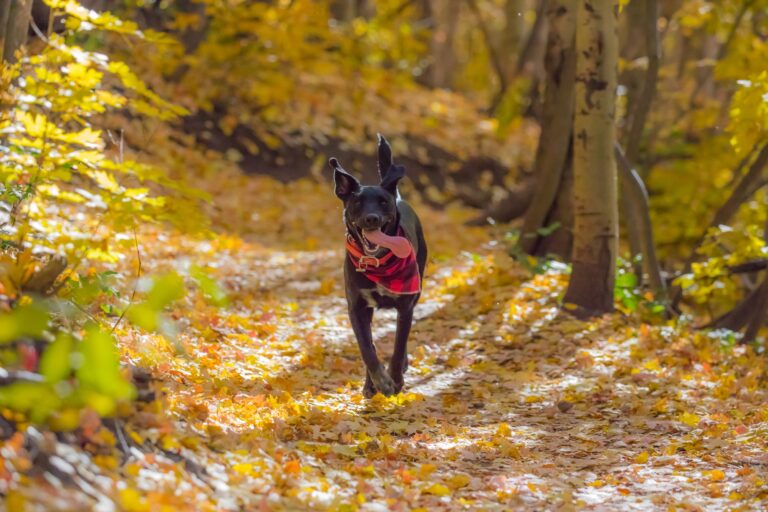We think that fresh, minimally processed food is a critical ingredient in your dog’s good health. But along with quality, feeding your dog the right quantity of food is key. Here, we’ll explain why precise portions—and calories—are so important, how we determine your dog’s plan and portions, and the difference between fresh food and kibble when it comes to the amount of food you get, and what that food provides for your dog.
Why is it important to be precise about portions?
Maintaining a healthy weight and body condition is one of the most important things you can do for the long-term health of your dog. And a healthy body condition is a lean body condition.
The majority of dogs in the U.S.— 56%—are overweight or obese. For a dog, being overweight isn’t a cosmetic issue; it comes with significant health consequences. In fact, many veterinary experts call it our pets’ biggest health threat as it’s linked to a whole raft of health problems including arthritis, chronic kidney disease, bladder/urinary tract disease, liver disease, diabetes, heart failure, high blood pressure, and cancer.
These same experts warn that it doesn’t take a lot of extra weight to start seeing these negative effects. While we tend to think of “a few pounds” in human terms—no big deal—for a dog, those few pounds can be a health hazard.
Studies have shown that being overweight was associated with lifespan reduction of two-and-a-half years. Conversely, overweight dogs may benefit from even just slight weight loss; one study showed that osteoarthritis can improve with a weight loss of just 6%. Read more about obesity and how to help your dog lose weight here.
Here’s a simple way to monitor your dog’s body condition:

Why do we measure portions in calories?
When the margin of good health might be only five or six pounds (and far less on a small dog), portion accuracy is critical. And to get accurate, you need to know how many calories your dog really needs each day.
If you’re a current, or former kibble-feeder, you may have only ever measured your dog’s meals in scoops or cups. But the guidelines found on kibble bags are too vague and don’t take into account your dog’s unique needs.
In addition to weight, there are many factors that will influence your dog’s dietary requirements, including breed, age, activity level, and whether they’re spayed or neutered. Standard kibble-bag feeding ranges don’t take these important factors into account and many owners end up over-feeding based on too-generous suggested portion sizes.
The Farmer’s Dog makes it easy to serve the right amount of calories for your particular pup. Our food comes in easy-to-serve packs, so there’s no measuring in cups or scoops.
For some customers, one pack = one portion.
For others, you may be feeding a portion of your pack at each meal.
How does The Farmer’s Dog calculate my pet’s portions?
When you sign up for a plan, we ask for several pieces of information about your dog. It seems like a lot of detail! But the more we get to know your dog, the better we can determine the right recipe and plan for them. We use the information you provide to calculate a baseline recommendation for your dog’s daily calorie requirements, also known as their daily portion. Since every dog, and metabolism, is unique, we use this as a starting place, and are always on hand to help with any necessary adjustments.
Here are the elements that go into our calculations and how they help us determine your portion:
Your dog’s age: Age can affect how much food your dog needs. Puppies and younger dogs may require more calories as they use some of that energy just in the process of growing! Dogs’ metabolisms also slow down as they age, just like ours do—they may require less energy to function and burn fewer calories. They may also be exercising at a less intense pace than before (though we definitely recommend keeping your older dog moving if possible!). At around age seven, depending on the breed, you may need to re-examine your dog’s caloric intake.
For puppies, we determine calories based on your dog’s predicted adult weight.
Whether or not your dog is neutered/spayed: This often gets overlooked, but when a dog is spayed or neutered it can reduce their energy requirement by 15% or more.
Your dog’s weight: Weight provides a starting place for determining how many calories we recommend. Once we have that starting point, we’ll use the other information you provide to get even more precise about our portions. Your dog’s body condition is a key factor we use to adjust and maintain the right amount of food as your dog grows and changes.
Your dog’s breed: From tiny to giant, and from Afghan to Yorkie, dogs come in an endless variety of shapes and sizes. And it’s not just the size variation that can have an impact on how much fuel your dog needs. Some dog breeds require more or less energy than others. Smaller breeds can have a higher metabolism than some bigger dogs and require slightly more calories per pound. Some breeds are also more genetically predisposed to obesity, including Labrador retrievers, Shetland sheepdogs, pugs, Basset hounds, dachshunds, Cavalier King Charles spaniels, and beagles. And, if you have a giant breed puppy, it’s important that they don’t grow too fast.
So, if you know your dog’s breed, it helps provide that much more insight to help us determine the ideal plan.
Your dog’s body type/condition: Body condition is a crucial measurement of your dog’s health. While we already know your dog’s weight, getting a picture of their condition is important, because every dog is different, and has different dietary needs. One 20-pound dog might be rail thin, and another might be chunky, and this is vital information when it comes to determining portion sizes. When you visit your veterinarian, they will assess your dog’s body condition by sight and touch using something called a Body Condition Score. Using a 1 to 9 -point scale that ranges from too-skinny (1) to obese (9), they will determine whether your dog needs to lose, maintain, or gain weight. You can see a Body Condition Score chart here.
It’s important, and easy, for you to keep an eye on this body condition over time.
Your dog’s activity level: With very few exceptions, all dogs should get a minimum of 30-minutes of exercise per day. But as with all things dog and human, one size does not fit all. Activity level can be a reflection of a dog’s breed, their personality, and your lifestyle. If your hobby is hiking, and your dog is always along for the adventure, they may need some extra fuel; if they’re a senior who’s happy to make it a few times around the block, it’s important to not let their weight creep up.
One thing to keep in mind is that even an active dog will gain weight if they’re being consistently overfed. The biggest factor in weight management is what’s in the food bowl.

Your dog’s “extras” (treats and scraps): Treats seem like they don’t count (they’re so small!). But they can add up. Most experts (including us!) advise that treats should make up no more than 10% of your dog’s daily diet. Sometimes it’s hard to figure out what 10% really looks like, and that’s another reason calorie-awareness is so important. It’s very easy to feed four or five of your dog’s favorite treats, or a few tablespoons of peanut butter, in the course of training (or just rewarding extreme cuteness). But if you know your dog should eat 400 calories a day, and the treats are 40 calories each… You can see how a handful of treats is adding too many calories, and, potentially, too much weight over time.
How does this information translate into the portions I receive?
The difference between daily portions and per-meal portions
Your dog’s daily portion is the total amount you feed per day. This is the total number of calories your dog needs.
One thing to keep in mind is that one pack may not translate to one meal or portion. Depending on your dog’s total daily calorie requirement, and how often you feed, you might be feeding a whole bag, or just part of a bag at each meal.
If my food comes in a large pack why do I feed only a portion? Why not just give me a smaller bag?
Good question. To allow us to make and deliver our food in the most cost-effective way for our customers, and to reduce our plastic usage, we don’t have an infinite number of pack sizes.
So, if you feed your dog 402 calories a day, you might get a 804-calorie pack and you’d feed a half of that pack per day.
Once we have all your information, our algorithm determines the appropriate recipe and daily caloric requirement for your dog. Based on how many calories you’re feeding each day, we determine the right pack size that you’ll receive in your box of food.
How do I portion out and serve my dog’s food?
For a full pack
- Squeeze the top of the bag to push the food down a little and clear space at the top of the pack.
- Cut straight across the pack near the top.
- Squeeze the food out of the bag.
- Rinse out the bag and recycle!
For a half-pack or quarter-pack
- Squeeze the middle of the pack across the full width of the bag so the food is squeezed toward the top and bottom of the pack.
- Cut the pack in half.
- Squeeze the food out of one of the half-bags. If you feed a half bag, squeeze out the entire half bag. If you feed a quarter bag, squeeze out half of that half bag.
- If you squeeze the side of the bag gently and tap the food will fall easily out of the bag.
- Place the remaining half pack in the cardboard container that comes with your food and place in the refrigerator.

Why does the food look “smaller” than what I’m used to?
If you’ve fed your dog kibble in the past, you might be surprised at the way The Farmer’s Dog food looks. Firstly, it looks more like the food you might eat! Second, you might think it looks “smaller” than what you’re used to. The reason for this is because our food is more nutrient-dense than kibble. In other words, gram for gram, there’s more energy, vitamins, minerals, and fatty acids that your dog’s body can use than in kibble. So even though it might look like “less,” it’s actually providing more.
For those interested, there’s more on this below.
How fresh food is made: We use human-grade protein and vegetables, which are gently cooked in a human-grade facility. So, the food that ends up in your bag retains its nutritional integrity. What’s more, your dog’s body can readily use those nutrients because our food is bioavailable. The Farmer’s Dog recipes have been proven via feeding tests to be not only complete and balanced, but bioavailable (read more about feeding tests here). Bioavailability simply refers to how easily a substance—like a nutrient—can be absorbed by a body. Fresh food also retains its moisture, which is important for a dog’s digestive health and satiety.






